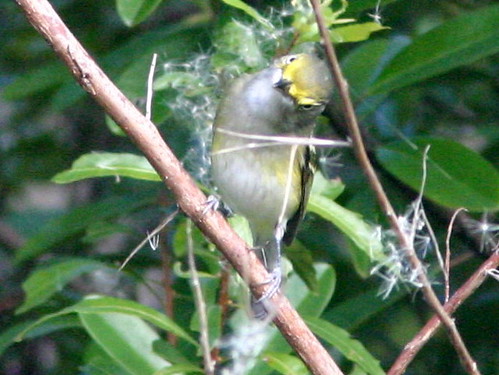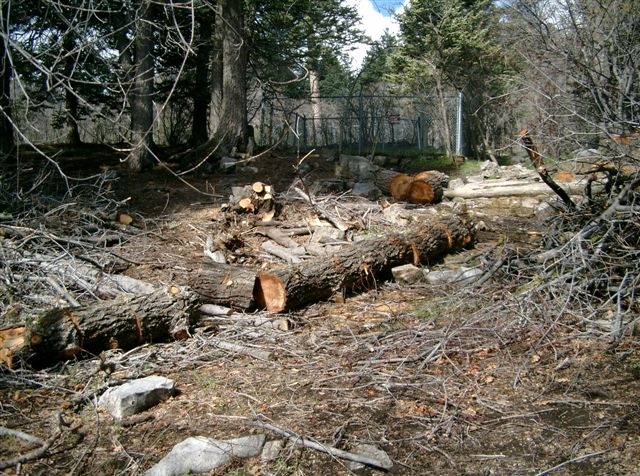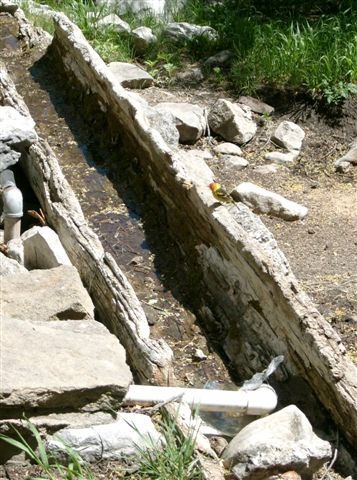Posted by: Ken @ 9:00 pm
 January 28: Flocks of up to over 100 rosy-finches of all three species are visiting Sandia Crest, New Mexico. Keep an eye on the weather and road conditions before setting out on the 13 mile climb to the top. Transmitters have been placed on some birds. Check out the links in rosyfinch.com for more information.
January 28: Flocks of up to over 100 rosy-finches of all three species are visiting Sandia Crest, New Mexico. Keep an eye on the weather and road conditions before setting out on the 13 mile climb to the top. Transmitters have been placed on some birds. Check out the links in rosyfinch.com for more information.
|
UPDATED ROSY-FINCH REPORTS
 Note: Temperature at Sandia Crest (10,678′) is usually about 11 degrees cooler than at this station in Cedar Crest (7100′). Click on icon for full Sandia Mountain weather outlook. Note: Temperature at Sandia Crest (10,678′) is usually about 11 degrees cooler than at this station in Cedar Crest (7100′). Click on icon for full Sandia Mountain weather outlook.Note from Feeder Project Coordinators
Date:January 28, 2009
From: Fran Lusso and Dave Weaver Hi Ken, Just back from the Crest - the road is clear with only an occasional icy patch from a bit of icy snow that blew through yesterday. The temperature was about 10 degrees with a strong wind - probably 30-40mph. Brisk! The log is attached.Best regards, Fran & Dave Latest Report from Rosy-Finch Banding Team: [We received the sad news that Steve Cox’s father passed away on January 24. We extend our condolences to Steve and his family. Carol Davis was in charge of the rosy-finch banding, and provided the report to Nancy. ] Date: January 25,2009 From Nancy Cox Hi all, Our crew banded only eleven Rosy-Finches today. Ten were Brown-capped and one was an interior Gray-crowned. Black Rosy-Finches were present but none were captured by the team. All three of the birds that were outfitted with transmitters last week were heard this morning. Link to updated banding spreadsheet Nancy = = = = = Date: January 18, 2009 From: Nancy & Steve Cox Hi all, Today we got to put transmitters on 3 birds (one of each species). It was very exciting and we were able to refind the Gray-crowned Rosy-Finch approximately 1/4 mile south of the Crest House around 4 p.m. The Black Rosy-Finch was west of the Crest House at 4:30 p.m. We also had the Brown-capped an hour after we banded it with a flock of Rosy-Finches near the Crest House. We newly banded 24 birds. There were 17 Brown-capped, 5 Blacks and 2 Gray-crowned (both were interiors). We had a lot of volunteers today as well as two Audubon groups from Texas (Dallas/Fort Worth and El Paso). Thanks for being so patient with the whole process. It was a nice day. The road was clear but we are hoping for snow during the week. …We had a lot of fun today with finally getting to put transmitters on the birds. We didn’t stay as long as planned but it was still a long day. They are going to try to do some more transmitter work throughout the week. Nancy & Steve Other Sightings
From NM RBA:
Bill Wittman on January 9 had a female AMERICAN THREE-TOED WOODPECKER and two GOLDEN-CROWNED KINGLETS at the Crest. John Parmeter saw the THREE-TOED on January 11 just below the trail to the Kiwanis Meadows. |
We have started a new Web page to document our Florida neighborhood “urban eagles,” now tending to one or more nestlings, the first of which hatched on January 17th:
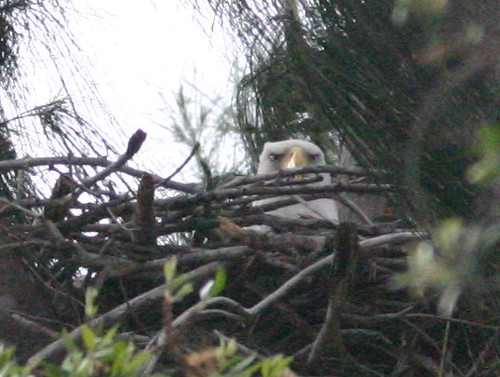
If you live in New Mexico, or have been following the links to correspondence and live Web camera views on rosyfinch.com, you are well aware that the Sandia Mountains have received significant snowfall. The sun often returns quickly after a storm, and the lower elevations dry out pretty quickly. The road up to Sandia Crest, though plowed, may be hazardous with icy patches and drifts of blowing snow, so please check the links to weather and road conditions and drive carefully.
Good flocks of all three rosy-finch species (including both the interior and coastal races of the White-crowned) have been visiting Sandia Crest since mid- November, and there has not been a single day when observers, who spent more than a few minutes there, recorded a failure to see the species at the Crest House feeders. The snow storms may have been a factor in finally bringing the rosy-finches back to the Kandahar Condominiums in Taos Ski Valley. Taos is 120 miles to the northeast of Albuquerque, and the birds usually get there earlier and remain later than at Sandia Crest. Inexplicably, the finches appeared at TSV more than a month later than at Sandia Crest.
Here in Florida, we are putting up with cool nights and daytime temperatures in the high 70s. On some morning walks, the easterly breezes feel downright cold, but instead of winter finches, we have to settle for back yard herons and Wood Storks.
Fishin’ Buddies, a Snowy Egret and a Pied-billed Grebe share a school of fish at the edge of our back lawn:
Quite a soggy little grebe: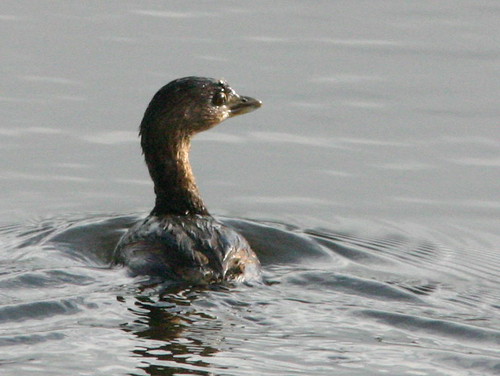
A couple of days earlier, this Tricolored Heron was also following the grebe around the lake shore: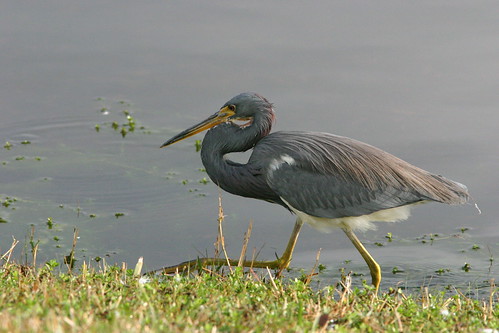
A Great Blue Heron is keeping me in view:

Wood Storks feeding in tandem:

I used to think that the Wood Stork shaded the water to better see its prey, but it actually fishes by touch rather than sight. Small fish are said to gather and concentrate in the shade of its outstretched wing: 
In our local patch of recovering Everglades, I encountered this White-eyed Vireo who had an attitude:
The vireo was singing loudly, but was well-hidden until it finally decided to pose for pictures: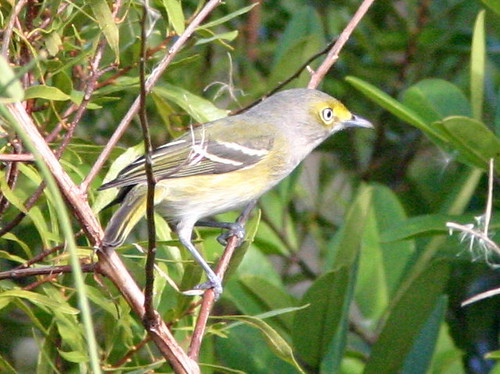
Prairie Warblers also winter in our neighborhood:
See our latest general Blog post here.
Posted by: Ken @ 11:09 am
These photos were taken at a wildlife drinker by remote cameras in Coyote Canyon, just south of Albuquerque on the west side of the Manzanita Mountains, a testing area for Sandia National Laboratories. They were originally e-mailed by an employee of Sandia Labs, are copyrighted by the owner and reproduced here for educational purposes. Note dates and times of the photos.
Not just one, but two mountain lions. My guess is that one of them is a female and the other is her year old cub, as adults avoid each other except, briefly, during the mating season, which is usually in the winter: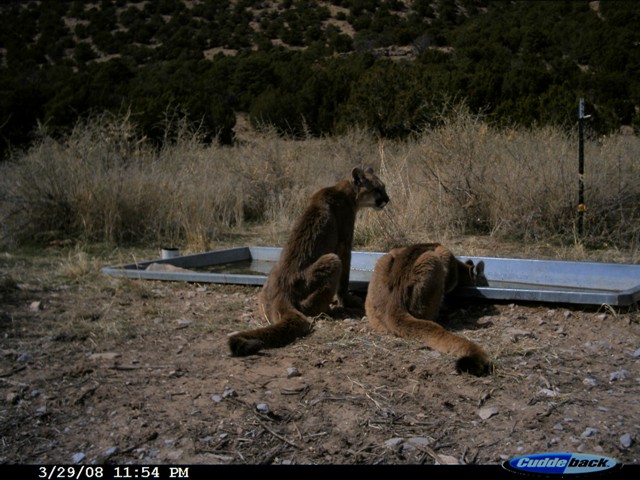
On the subject of mountain lions, at the end of this post is a newspaper account of an evening attack on a 5 year old boy that took place this past week in the Sandia Mountains at Balsam Glade, one of my favorite spots (in the daytime). Happily, the child is expected to recover despite suffering several deep lacerations.
Birders have also reported sighting these big cats at Capulin Spring, which is just above the location of the attack. Click for a scrolling panoramic view from the overlook at Balsam Glade (requires Java).
Here, a striped skunk and a fox compete for drinking rights. Gray foxes are the most common montane fox species in Central New Mexico, but the shape of the fox (proportionally shorter legs, longer ears and longer tail) and the lack of a dorsal black stripe on its lower back and tail suggest that it may be a kit fox. The latter species may favor open areas such as these Manzanita foothills. However, I welcome other opinions as to the identification of this canid:
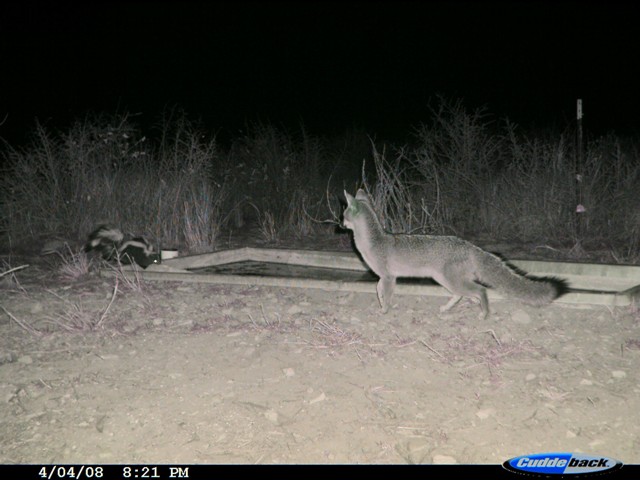
Again, this fox has very large ears and distinct muzzle markings that may characterize it as a kit fox:
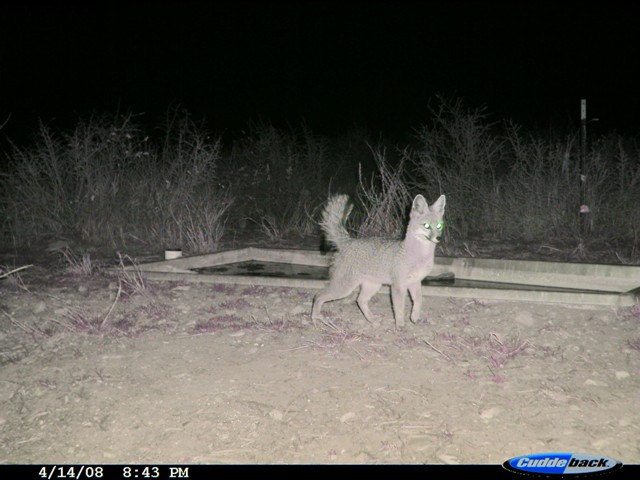
Prey species such as these six mule deer also visit the watering hole, reminiscent of Africam: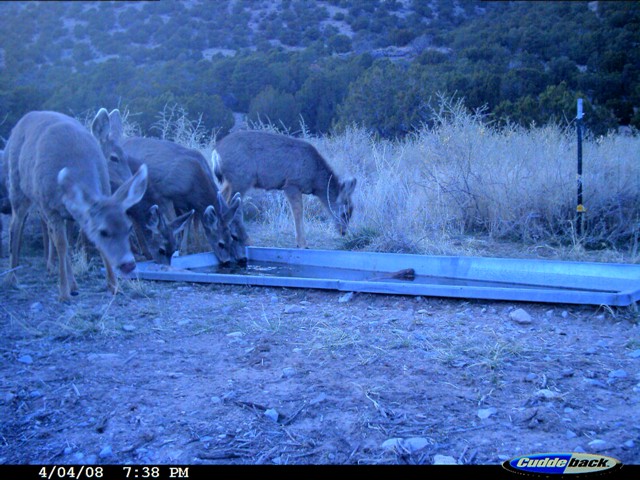
Coyotes in the morning…: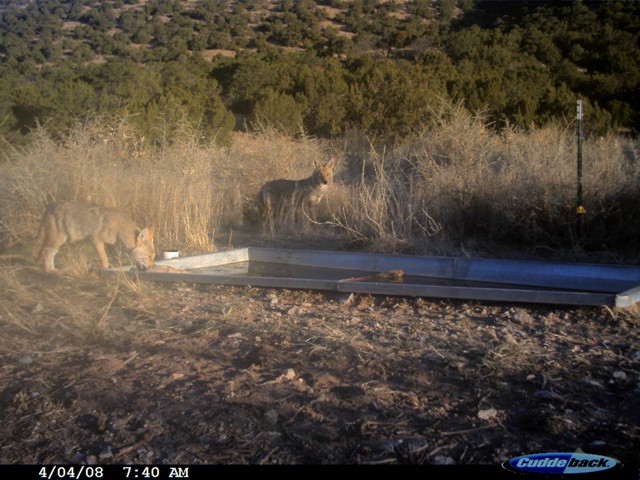
…and a Black Bear in the dead of night:
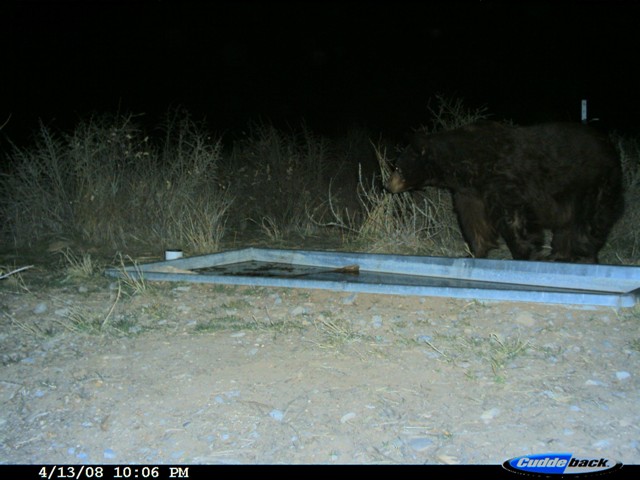
While we were staying at our second home in Illinois last month, a full grown cougar (aka mountain lion, panther or puma) was shot by police in downtown Chicago.
Mountain lion sightings, though infrequent, are not unusual in the Sandia Mountains. One morning I listened to a local Albuquerque radio station traffic helicopter reporter tracking a mountain lion as it walked down the middle of Tramway Boulevard at rush hour. While we lived in Cedar Crest, one visited our subdivision with its cub, and another enjoyed basking early on winter mornings in the warm pavement of a tennis court at a nearby residential boys’ school. Cougars have benefited by the discontinuance of bounty hunting, although in New Mexico, they are still hunted with dogs during hunting season.
Interesting information is available at this site, which includes some important advice about how to avoid an attack.
Mountain Lion Attacks On People in the U.S. and Canada
“[I]ncreases in apparently mountain lion sightings have led to general hysteria over mountain lion attacks, and the common conception that something has changed in cougar behavior. However, an extremely simple analysis of the data shows that nothing has changed in cougar behavior at all. The increased number of attacks is explained simply by the increase in the number of people, and the rebound in cougar populations after bounty hunting ceased…”
If you happen to cross paths with a black bear in the wild, it is best not to look it in the eye, and slowly retreat. Bears tend not to be easily intimidated. We had one in our back yard that had a cub with it. When I started banging pots and pans, she just stared back at me,
“The general advice to avoid being eaten by a mountain lion is to travel in groups. If you encounter a mountain lion by yourself or with your children, stop, make yourself look as big as possible, and pick up small children and put them on your shoulders to make you appear even larger. Aggressively defend your position. The idea is to deter their attack by making them think that it isn’t going to be easy for them.”
Monday, May 19, 2008
Animal Attacks 5-Year-Old in Sandias
By Jeremy HuntJournal Staff Writer
© ABQJournal.com and Albuquerque Journal
It was a scream, his father said later, that you never want to hear.
Five-year-old Jose Salazar Jr. walked around a bend as the family was hiking Saturday evening on the Balsam Glade Nature Trail in the Cibola National Forest. He was momentarily out of sight of his family, 20 to 30 feet behind him, when he screamed.
A big cat, most likely a cougar, had tackled Jose and was batting at him, and when Jose’s parents rushed forward, the cat picked the boy up by the neck, dragged him down the mountainside and was only stopped by a fallen tree…
State Game and Fish Department officials, however, said Sunday afternoon they weren’t sure what kind of animal had attacked little Jose. A veteran tracker and his dogs had gone to the trail Saturday shortly afterward and were unable to find signs of a cougar…
The boy, shown pictures brought to the hospital by Game and Fish, identified the animal as a “big cat.” So did his father, although Charlotte Salazar said it looked like a large bobcat…
For the full story, see: URL: http://www.abqjournal.com/paperboy/text//news/state/307308nm05-19-08.htm
Posted by: Ken @ 10:56 am
 Update on the Rosy-Finches of Sandia Crest, New Mexico. The flag is waving–
Update on the Rosy-Finches of Sandia Crest, New Mexico. The flag is waving–small flocks of Rosy-Finches are still visiting the feeders at Sandia Crest House.
US Forest Service Announces Decision on Construction Involving the Capulin Spring “Bird Log”
At both ends of the day, Northern Saw-whet and Northern Pygmy-Owls may be heard and seen, and early summer evenings and nights are usually filled with the calls of Flammulated Owls, Poor-wills, and the occasional caterwaul of a Mountain Lion. Every bird and most mammals that live anywhere near the spring utilize it, as it is the only constant source of water in an area of several square miles. It is a reliable spot for Band-tailed Pigeons, McGillivray’s Warblers and all of their cousins that breed and migrate through: Black-headed Grosbeaks, a variety of orioles, vireos, woodpeckers and sapsuckers… not to mention the occasional deer, bobcat, squirrel, chipmunk, Black Bear, Long-tailed Weasel, and at least one lion sighting. In good years it is a magnet for Cassin’s Finches, Red Crossbills, and Clark’s Nutcrackers.
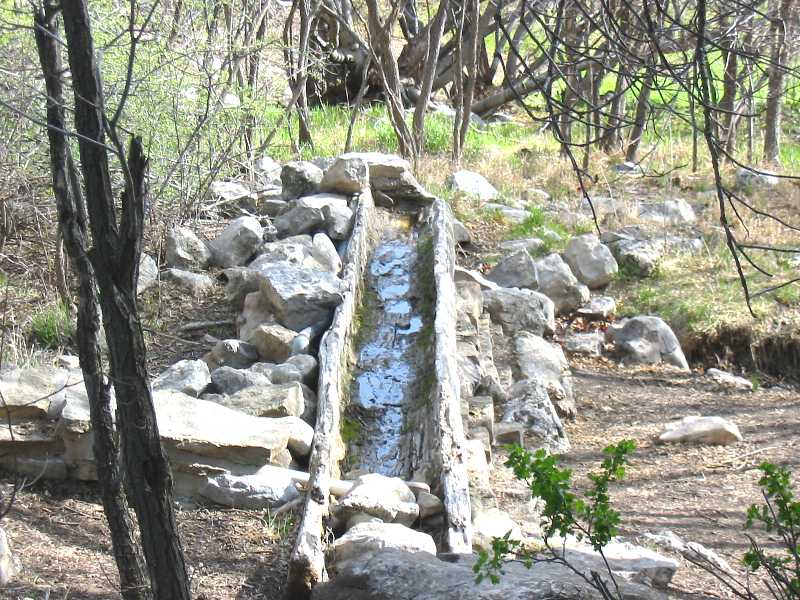
The log itself, crafted out of a naturally hollowed-out trunk of a huge tree (possibly Douglas-fir), has endured for many years. During the late 1990s it began to leak. Pipes that carried water from the spring to the log were cracked by vandals and the action of freezing and thawing. Water that did make it to the log from the spring just passed directly onto the ground through a large area of wet rot at the spot where the water dripped down from the pipe. Mary Lou and I worked with Central New Mexico Audubon and US Forest Service volunteers to repair the log, replacing the pipe and re-routing it through a newly reconstructed stone wall. We fashioned a rubber bladder for the base of the log, and once again water trickled through it to form an ideal “bird bath.” [See, under “Comments” below, the bird list we compiled just while working on restoration of the log and plumbing– 22 species!].
It is a photographer’s delight, as the orientation of the log provides great viewing of its long axis from a shaded observation area on a small bluff about 20 feet away. Best, it is usually out of the way of the casual party types who don’t know what they are missing down the loop, behind the trees.
Both Alternatives #1 and #2 proposed modifications and improvements to the Capulin Picnic Area, which includes the bird viewing log at Capulin Spring, specifically:
- Replacing all damaged or broken concrete picnic tables with accessible picnic tables.
- Replacing existing fire rings with pedestal grills for easier accessibility and fire safety.
- Installing animal resistant garbage cans.
- Constructing accessible paths from existing picnic areas and parking lot to restroom facilities.
- Refurbishing and reconstructing existing retaining walls.
- Reconstructing the fence around Capulin Spring.
- Replacing existing steel cable and railroad tie barriers with concrete traffic control devices.
- Eliminating the last 150 feet of asphalt at the end of the road with loop and turned into a foot trail.
- Replace the existing vault toilets with accessible vault toilets.
- Reroute
the access road from the existing intersection with Highway 536 (Crest Highway) south approximately 250 feet to provide safer access and better sight distance to and from the Crest Highway.
The proposals and detailed maps are available at: http://www.fs.fed.us/r3/cibola/projects/nepa_reports.shtml
Alternative #1 would improve the roadways and parking/ picnic/
gathering facilities, but also attract many more visitors to this
pristine area.
Alternative #2 would close the entire roadway below the one-way road
gate to vehicular traffic. Alternative #3 would essentially be to do nothing.
Alternative #1 would involve rather extensive construction and offered great improvements in access for the general
public and the handicapped, while #2 would provide less disturbance for
birds and birders, yet would pose a problem accessing the log viewing
area for those with limited mobility. Both would replace the log with a
new one and improve the bird viewing area.
See related comments in this earlier ROSYFINCH RAMBLINGS Post
Decision Paper
Based upon my review of the analysis of effects in the Environmental Assessment and considering the public comments I have received on the proposal, I have decided to implement Alternative 2 which provides for the following actions:
Relocation of the Capulin access road intersection with Highway 536.
Relocate the access road from the existing intersection with Highway 536 (Crest Highway) south approximately 250 feet. The existing turn lane would be removed, and a new turn lane would be constructed for the relocated intersection.
Restoration and Improvement of the Capulin Picnic Area:
The majority of the sites northeast of the gate would be removed and the sites replanted. There would be five tables which would be placed east of the gate near the lower bathroom. Pedestal grills would be installed near the five picnic tables. The table at the end of the existing loop will be replaced. The cinder-block toilet near the gate will be demolished and the existing toilet towards the end of the one lane road be replaced. The road would be left for administrative uses only. Six parking spaces would be constructed above the gate, making the one lane road available for walk-in traffic by the public. The drinker near Capulin Spring would be replaced with a natural log cut from a dead tree in the local area.

(Click on photo for larger view)
There is a special place at 8600 feet elevation in the Sandia Mountains just east of Albuquerque. I took the above photo one morning in early May of 2003. Sunlight dappled through the leaves of the large Rocky Mountain Maples that thrived in the moist runoff of Capulin Spring. Water from the spring flowed through a pipe and was diverted into a trough formed by an ancient hollow log. Water is scarce in the mountains, and the “Bird Log,” as it is called, attracts most of the creatures that call the mountain their home. One needs only find a comfortable place to sit and simply wait for the birds to come in to drink and bathe.
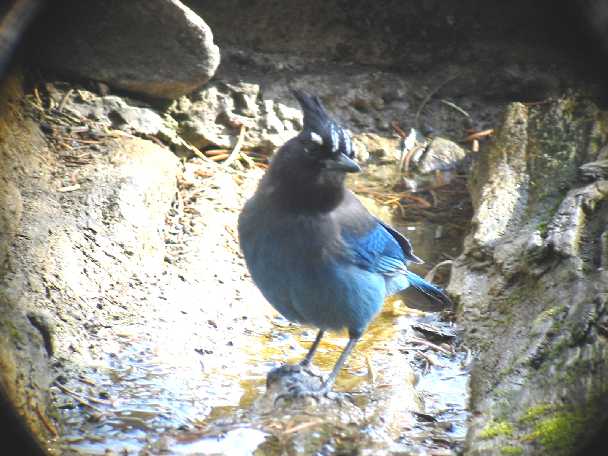 The log is especially popular with birds and birders during spring and fall migration. Even when we arrived early, we often found fellow birders already set up with cushions and binoculars. Birders sometimes gain a sense of “ownership” of such a special place, forgetting that the National Forest actually belongs to everyone. One day a young lady bushwhacked up the hill to the log and propped her back against the log to write (poetry or a love letter?) and enjoy the sounds and sights of nature. She was seemingly unaware of our presence or that she had interrupted our viewing of Western Tanagers, Black-headed Grosbeaks and an assortment of warblers and woodpeckers. Like the thirsty birds, we had to wait for her departure or simply find better hunting grounds.
The log is especially popular with birds and birders during spring and fall migration. Even when we arrived early, we often found fellow birders already set up with cushions and binoculars. Birders sometimes gain a sense of “ownership” of such a special place, forgetting that the National Forest actually belongs to everyone. One day a young lady bushwhacked up the hill to the log and propped her back against the log to write (poetry or a love letter?) and enjoy the sounds and sights of nature. She was seemingly unaware of our presence or that she had interrupted our viewing of Western Tanagers, Black-headed Grosbeaks and an assortment of warblers and woodpeckers. Like the thirsty birds, we had to wait for her departure or simply find better hunting grounds.
During the past several years, the health of the forest has been threatened by drought, disease and insect infestation. Piñon Pines had already been decimated by the bark beetle epidemic, and now death and destruction has spread up the mountain to the White Pines and Douglas-firs. Adding to the damage produced by broom rust, root rot and chewing, sucking and boring insects, the unusually severe winter of 2006-7 produced a heavy snow load and high winds. The task of clearing the fallen and damaged trees far exceeded the staff capabilities of the US Forest Service. Sandia Ranger District volunteers and members of the Friends of the Sandia Mountains are still working hard to clear fallen trees and minimize hazards. Sally Lowder kindly provided the following three photos. The first, taken on May 8, 2007, shows that the area around the Bird Log was not spared:
Happily, the log itself was not damaged by any fallen trees or limbs, but the majestic old maple trees were devastated. The log was in full sunlight as cleanup progressed:. Note the male Western Tanager on the rim:
Nature has wondrous healing powers, and birders were pleased to see how rapidly the saplings invaded the area. Shoots from the old Rocky Mountain Maple that shaded the log (its stump can be seen behind the log in the photo below) are reaching skyward. 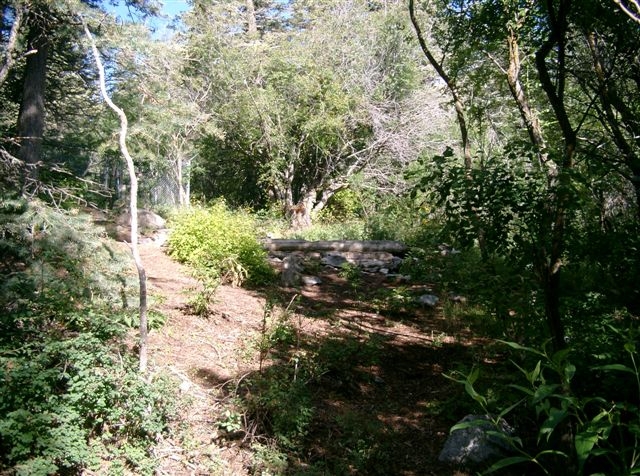
For more about “The Log” and directions follow this link:
http://www.rosyfinch.com/sandia.html#THE_LOG_AT_CAPULIN_SPRING













